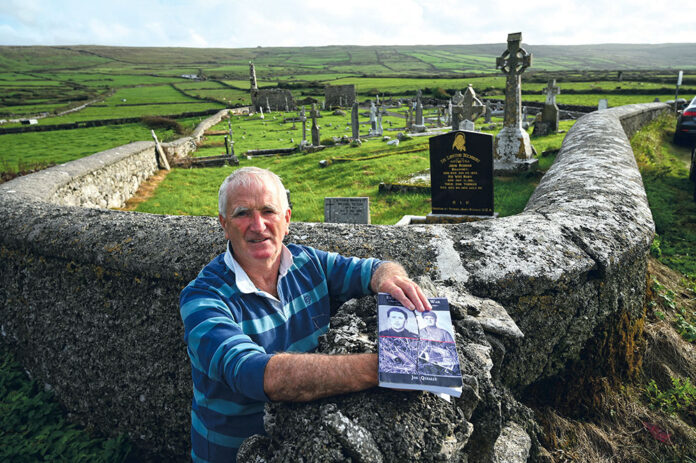Two violent historical episodes in the years after Irish civil war are investigated by north Clare writer
WHILE the Civil War ended in 1923, the division and bitterness remained for decades after.
The fallout from the conflict forms the background to historian Joe Queally’s book, Echoes from a Civil War, which is about to be launched.
It looks at two incidents in the years that followed; firstly the killing of Garda Thomas Dowling, a Kilkenny man, who was shot four times in Fanore on December 28, 1925, by people who ambushed him from inside a stonewall next to the graveyard in the townland of Craggagh.
Four years later on June 11, 1929, in Tullycrine in the parish of Kilmurry McMahon, Garda Timothy (Tadgh) O’Sullivan, a Corkman, was blown to pieces by a bomb on the roadside.
It is believed that neither man was the intended target.
Joe’s exhaustive research finds the men who were supposed to be killed on the two nights in question, while he has also tried to find the facts from the time, with interviews from elderly people, along with recollections from old IRA men, who shared their stories of a sad and tragic period.
The title Echoes from a Civil War reflects the fact that the killings were both sparked by a deep seated resentment from the conflict.
“That time, with the signing of the Treaty people took sides. We had been attacked by the Danes, the Spaniards and the English and the worst thing of all was we attacked ourselves, with the Civil War. That lingered for years afterwards, it lasted a lifetime, some people would say it’s still there,” says Joe.
“All of those people had fought together, with the IRA to free our country, but it pitted father against son, brother against brother. That was the worst of all.”
For the anti Treaty side, the Gardai were not widely accepted in much of Clare.
He also feels that perceived bias around the reallocation of land was reinforcing divisions at the time.
“There was a lot of stuff in the mix there,” he reflects.
However, he says Driscoll, the intenended target of the Tullycrine attack had not been linked with the Pro Treaty side.
“He had no record at all, he hadn’t fought at all. I could get no record of him going back. He was a notorious man after the IRA, so they decided to get rid of him with a booby trap bomb, that was the size of a shoebox.”
He said he couldn’t comprehend how they developed such a bomb at the time, but found out on a visit to Derry.
“How did they come up with it that time? I could find no one to tell me how they did it, but I went up to the funeral of Martin McGuinness in the Bogside, they knew how to make it and they told me.
“It was a mixture of fertilizer, 7% parafin oil and 10% of petroleum jelly, which is basically vaseline.
“Then they put ball bearings and horse shoe nails into it and they fired it up with possibly a battery and when he pulled the lid off the bottle, it blew up.”
Joe’s own mother heard the shots on the night of the Fanore killing, but he says in the early stages of his research he was prioritising official records rather than the stories of the people living in the two areas at the time, something he later realised the significance of.
“Now I see it’s the most important part of the book. People who heard the shots, saw the people, heard the bomb going off, saw the box for the bomb in the workshop when it was being made.”
There are comments from people in the area in Fanore who heard and saw activity on the day in question, as well as similar recollections from the Tullycrine area, including one from Jack Rediy who felt his house shake due to the force of the bomb.
Joe also has a range of photos of interest and has really got as close as possible to the two incidents, despite the long time lapse.
No-one was ever charged with the Tullycrine killing, while three men were acquitted of the Fanore shooting.
Joe says the case started to come apart when police brutality emerged, which he says was not unlike the tactics used by police in the investigation that led to the imprisonment of the Birmingham Six over 40 years later.
In what was a time of fear, no-one spoke to the investigators and Joe says that is one of the striking things about the incidents.
“The parish didn’t budge, the village didn’t budge, the boreen didn’t budge. They offered big money in west Clare and people were poor that time, £100 was like €100,000 but people didn’t budge.”
Echoes From a Civil War will be launched at Teach Cheoil in Ennistymon (the old Church of Ireland building) on Friday, October 29 at 8pm.
There will also be a launch at Murty Browne’s pub in Tullycrine on Thursday, November 4 at 9pm.
The launches will feature an exhibition of materials similar to those used on the night of both killings, the slug cartridges used in the Fanore ambush and the materials used in the making of the ‘booby trap bomb’ in Tullycrine.
At both launches there will be a half hour documentary film, ‘The Banner Bomb’, commissioned by RTE Scannal team who came to Tullycrine to re-enact the story of what became known all over the country as the ‘Tullycrine box bomb’.
North Clare native former Chief Superintendent of An Garda Síochána, John Kerin will perform the Ennistymon launch. The Tullycrine launch will be by Paddy and Kitty Dillon from Knockaderreen, Tullycrine and Michael Houlihan, Tullycrine and Cratloe.
An open invitation to one and all to come out to share in the stories from the past and to ask questions and hopefully find answers to what happened nearly 100 years ago in North and West Clare.
Doors at both launches will open one hour before the appointed hour to allow time for people to view the exhibits.
Books can be purchased online at www.echoesfromacivilwar.ie and further information is available from the author at joequeally@yahoo.com.
by Owen Ryan



